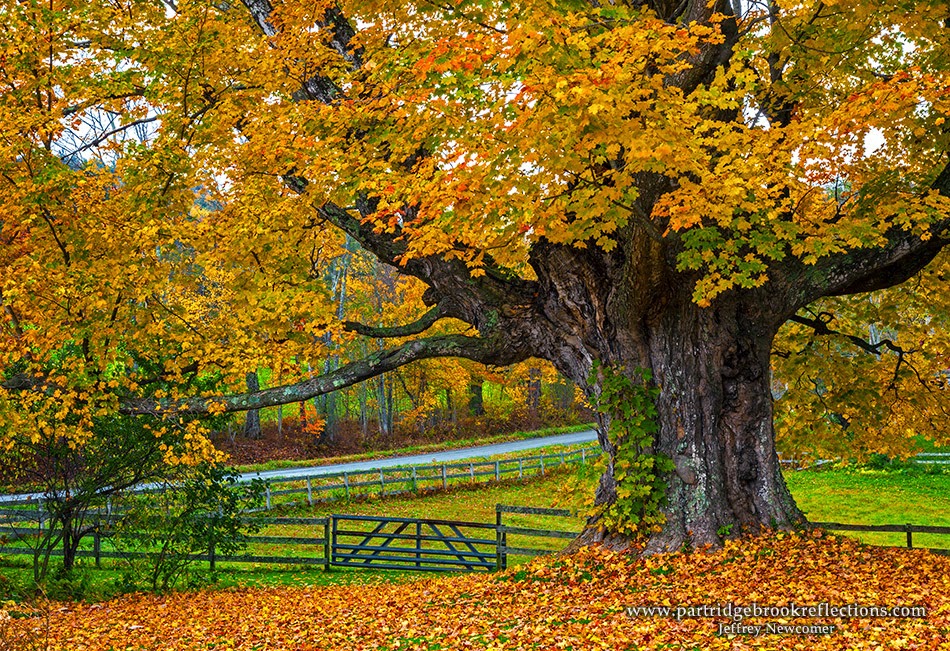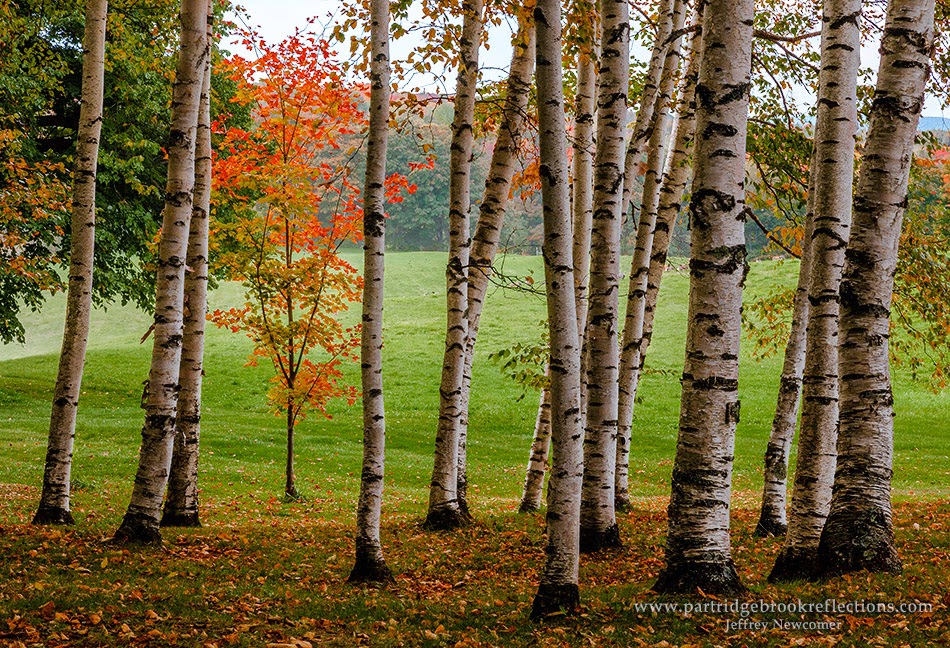 |
| Ancient Sugar Maple, Guilford, Vt. |
The fall colors are still building in the Monadnock Region, but my October file directory is already filling with stuff that I can't
 |
| Spofford Lake Fog |
So, in no particular order:
Color Doesn't Need to Overwhelm
 |
| Through Birches |
 |
| Dummerston, Vt |
I have always liked the way the grassy road leads to the small house in Dummerston, Vermont, but the bright orange trees were just enough to, even more strongly, draw the eye.
Small Compositions
 |
| Harrisville, NH |
 |
| Climbers Pomfret, Vt |
Bad Weather is Your Friend
 |
| Spofford, NH |
 while it lasts, foul weather is great weather to capture the full beauty of the season. A couple of days ago I took Nellie for a early morning walk to Spofford Lake. The fog was slowly rising, but I was still able to use the mist to provide a sense of depth and drama to the color. Nellie had no idea why I was running around trying to place the fog in as many interesting places as possible.
while it lasts, foul weather is great weather to capture the full beauty of the season. A couple of days ago I took Nellie for a early morning walk to Spofford Lake. The fog was slowly rising, but I was still able to use the mist to provide a sense of depth and drama to the color. Nellie had no idea why I was running around trying to place the fog in as many interesting places as possible. 
A week ago I was cruising central Vermont for foliage. The weather began bright, but, as is often true, the clouds gathered as the day progressed. As I explore the road through Pomfret I found this old barn engulfed in foliage that was enriched by the soft light. Even in the overcast my polarizer helped to bring out more of the deep colors.
Focus on the Foreground
"Focus on the foreground", is an often heard axiom of landscape
photography. A strong foreground provides depth to an image and
 |
| Jenne Farm, Reading, Vt |
 |
| Sleepy Hollow Drop |
Another over done classic is the Sleepy Hollow Farm along Cloudland Road in Pomfret, Vermont. On this day the imposing, video monitored, gate was inexplicably open and I was able to sneak to the side of the drive to focus on the colorful foreground leaves. This seemed to add warmth to this often cold and too perfect scene.
Soft Focus to Draw the Eye
Landscape photography is about clearly seeing the landscape, and I spend a great deal of my photographic efforts trying to get images that are sharp, front to back. The argument is that this best duplicates the way we see a scene with our own remarkable eyes,
 |
| Marlborough, NH |
Travel Both Ways
A few days ago I was exploring the fall color around Harrisville and Nelson, New Hampshire. It happens less often these days, but I
 |
| Harrisville, NH |
Never Trust a Cow
The challenge of cow photography is to try not to be seen. Whenever I find a classically bucolic scene with cows randomly grazing in a pasture, I know that I have to be quiet and stealthy. As
 soon as they are aware of your presence cows typically stop doing cow-like stuff, turn toward the camera, often wandering over to say hello. They consistently follow this pattern EXCEPT when you want them to do it. A few days ago, I was shooting a cow grazing a field in Chesterfield. She was wandering along the fence and I wanted to frame her looking at the camera with the background of fall foliage along the road. No way. She stubbornly presented me with her business end and no amount of clicking, stomping or arm waving could induce her to say hello. I had to settle for an image of the lonely heifer gazing down the road for, who knows what. Cows are very undependable animals.
soon as they are aware of your presence cows typically stop doing cow-like stuff, turn toward the camera, often wandering over to say hello. They consistently follow this pattern EXCEPT when you want them to do it. A few days ago, I was shooting a cow grazing a field in Chesterfield. She was wandering along the fence and I wanted to frame her looking at the camera with the background of fall foliage along the road. No way. She stubbornly presented me with her business end and no amount of clicking, stomping or arm waving could induce her to say hello. I had to settle for an image of the lonely heifer gazing down the road for, who knows what. Cows are very undependable animals.
 |
| Keene, NH |
So these are just a few thoughts from my recent autumn photography. Most are not restricted to the foliage season. Every picture we take has its own story and lessons to teach. By carefully considering why each image succeeds or fails you can steadily improve your ability to communicate and inspire.
It looks like the coming week will be persistently stormy and that may blow away this year's color, but, while some color persists, get out there and have fun and learn something. November is fast approaching.
Jeffrey Newcomer
Partridgebrookreflections.com

Your "Lessons from Autumn" blog post is a poetic exploration of the beauty and metaphorical richness of the season. The vivid descriptions and stunning photographs truly capture the essence of autumn's transformative allure. The way you intertwine personal reflections with the visual feast of autumn leaves creates a compelling narrative. Candid Wedding Photography In Chennai It's a reminder to embrace change and find beauty in transitions. Your blog post beautifully conveys the magic of autumn, making it a delightful read for anyone appreciating nature's artistry.
ReplyDelete